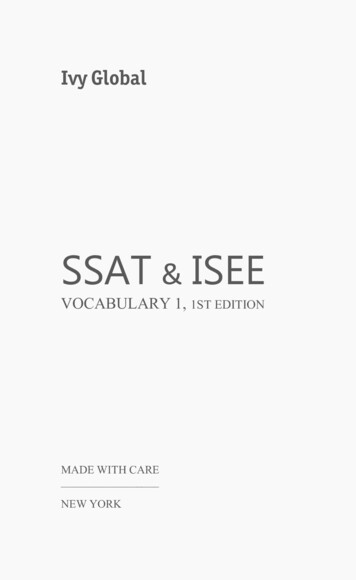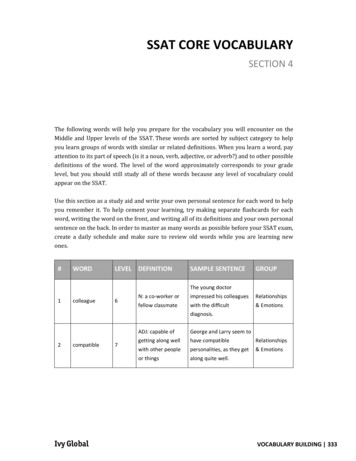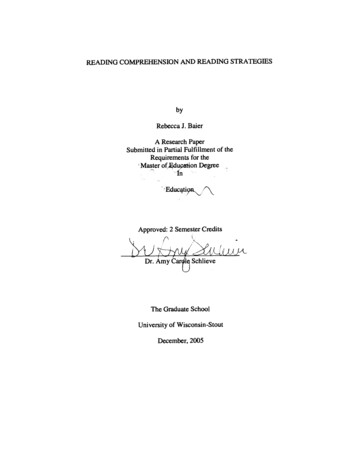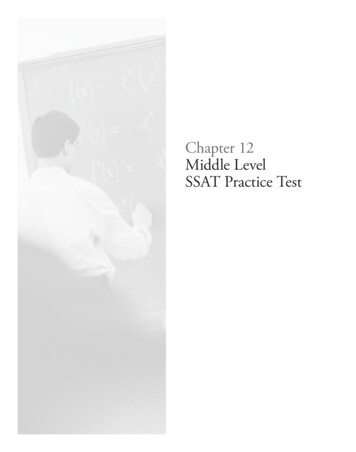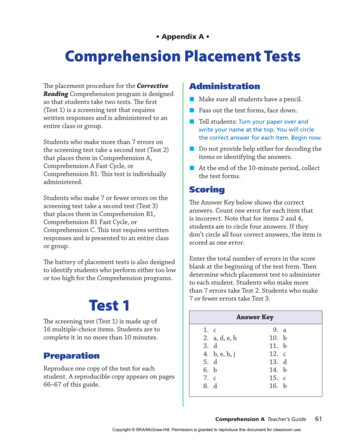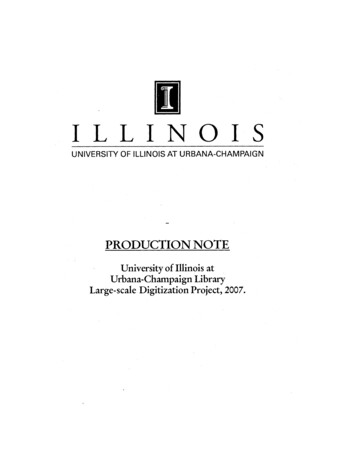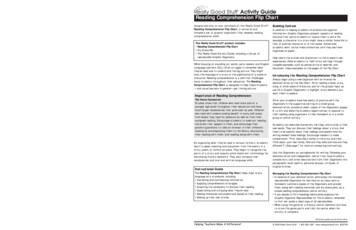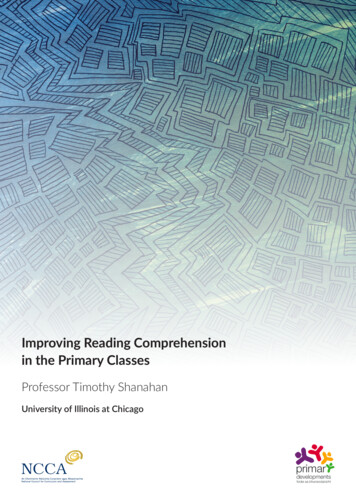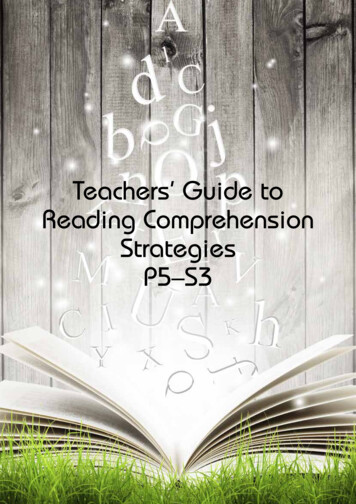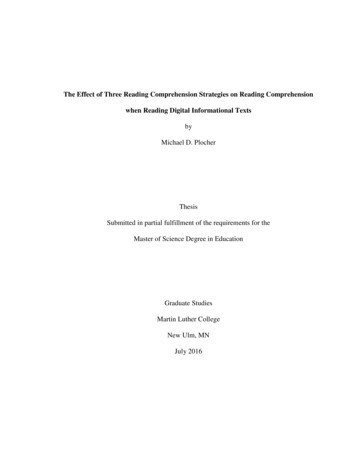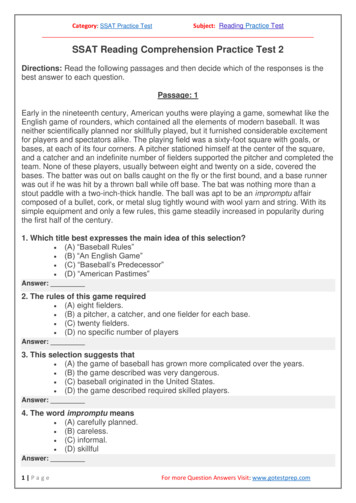
Transcription
Category: SSAT Practice TestSubject: Reading Practice TestSSAT Reading Comprehension Practice Test 2Directions: Read the following passages and then decide which of the responses is thebest answer to each question.Passage: 1Early in the nineteenth century, American youths were playing a game, somewhat like theEnglish game of rounders, which contained all the elements of modern baseball. It wasneither scientifically planned nor skillfully played, but it furnished considerable excitementfor players and spectators alike. The playing field was a sixty-foot square with goals, orbases, at each of its four corners. A pitcher stationed himself at the center of the square,and a catcher and an indefinite number of fielders supported the pitcher and completed theteam. None of these players, usually between eight and twenty on a side, covered thebases. The batter was out on balls caught on the fly or the first bound, and a base runnerwas out if he was hit by a thrown ball while off base. The bat was nothing more than astout paddle with a two-inch-thick handle. The ball was apt to be an impromptu affaircomposed of a bullet, cork, or metal slug tightly wound with wool yarn and string. With itssimple equipment and only a few rules, this game steadily increased in popularity duringthe first half of the century.1. Which title best expresses the main idea of this selection? (A) “Baseball Rules” (B) “An English Game” (C) “Baseball’s Predecessor” (D) “American Pastimes”Answer:2. The rules of this game required (A) eight fielders. (B) a pitcher, a catcher, and one fielder for each base. (C) twenty fielders. (D) no specific number of playersAnswer:3. This selection suggests that (A) the game of baseball has grown more complicated over the years. (B) the game described was very dangerous. (C) baseball originated in the United States. (D) the game described required skilled players.Answer:4. The word impromptu means (A) carefully planned. (B) careless. (C) informal. (D) skillfulAnswer:1 PageFor more Question Answers Visit: www.gotestprep.com
Category: SSAT Practice TestSubject: Reading Practice TestPassage: 2John J. Audubon, a bird watcher, once noticed that a pair of phoebes nested in the sameplace year after year, and he wondered if they might be the same birds. He put tiny silverbands on their legs, and the next spring the banded birds returned to the same nestingplace. This pair of phoebes were the first birds to be banded. Since that time, naturalists,with the aid of the federal government’s Fish and Wildlife Department, band birds in aneffort to study them. The bands, which are made of lightweight aluminum so as not to harmthe birds, bear a message requesting finders to notify the department. Careful records ofthese notifications are kept and analyzed. In this way, naturalists have gained a great dealof knowledge about the nesting habits, migration patterns, and populations of a largevariety of bird species. Most importantly, they are able to identify those species that are indanger of extinction5. Which title below best expresses the main idea of this passage? (A) “The Migration of Birds” (B) “One Method of Studying Birds” (C) “The Habits of Birds” (D) “The Work of John Audubon”Answer:6. Audubon’s purpose in banding the phoebes was to (A) satisfy his own curiosity. (B) start a government study of birds. (C) gain fame as the first birdbander. (D) chart the phoebe’s migration patterns.Answer:7. Audubon proved his theory that (A) silver and aluminum are the best metals for birdbands. (B) the government should study birds. (C) phoebes are the most interesting birds to study. (D) birds return to the same nesting place each springAnswer:8. The word habits means (A) naturalists. (B) living environments. (C) behaviors. (D) ecosystem.Answer:Passage: 32 PageFor more Question Answers Visit: www.gotestprep.com
Category: SSAT Practice TestSubject: Reading Practice TestAn ancient dinosaur-like animal called the Archaeopteryx has long been considered to bethe world’s first bird. Based on what has been pieced together from fossilevidence, Archaeopteryx was more like a cross between a bird and a dinosaur, rather thanfitting clearly in one group or the other. It had teeth, a tail, and claws on its wing—allcharacteristics that more closely resemble dinosaurs. It also had feathers and wings, liketoday’s birds. Whether the creature was a bird with teeth or a feather-covered dinosaur is amatter of debate, but its existence proved that a link exists between birds and reptiles.A recent discovery leads us to question the accepted wisdom of Archaeopteryx as the firstknown bird. According to an article in National Geographic magazine by author BrianSwitek, a creature known as Aurornis xui was described by paleontologist Pascal Godefroitin May of 2013. Aurornis was discovered in China. It is believed to have lived 160 millionyears ago, about 10 million years before Archaeopteryx.Switek notes that controversy exists over whether Archaeopteryx even was a bird. But forthose who believe it was, it appears that it may not have been the first.Researchers cannot say with certainty that Aurornis was a bird either. There are too fewdetails in the fossil record to make this determination definitively. But one thing based onthese discoveries is clear: birds are descendants of dinosaurs. Today’s common birdshares an ancestry with predator dinosaurs such as the velociraptor, lending even moremeaning to the idea that the early bird gets the worm.9. Which title best expresses the topic of this selection? (A) “Studying Dinosaurs” (B) “The Earliest Birds” (C) “Birds versus Dinosaurs” (D) “The History of the Velociraptor”Answer:10. According to the passage, Archaeopteryx could best be described as (A) an ancient bird without feathers. (B) more like a dinosaur than a bird. (C) part bird and part dinosaur. (D) more like a mammal than a reptile.Answer:11. In the context of the passage, the phrase accepted wisdom most nearly means (A) invalid theory. (B) historical myth. (C) helpful advice. (D) widely held view.Answer:12. According to the passage, today’s birds are descendants of (A) dinosaurs that hunted other animals. (B) land-based dinosaurs without tails. (C) dinosaurs that ate vegetarian diets. (D) ancient Egyptian and Asian reptiles.Answer:3 PageFor more Question Answers Visit: www.gotestprep.com
Category: SSAT Practice TestSubject: Reading Practice TestPassage: 4The proud, noble American eagle appears on one side of the Great Seal of the UnitedStates, which is printed on every dollar bill. The same majestic bird can be seen on stateseals, half dollars, and even in some commercial advertising. In fact, though we oftenencounter artistic representations of our national symbol, it is rarely seen alive in its nativehabitat. It is now all but extinct.In the days of the founding fathers, the American eagle resided in nearly every corner ofthe territory now known as the continental United States. Today the eagle survives in whatornithologists call significant numbers only in two regions. An estimated 350 pairs inhabitFlorida, and perhaps another 150 live in the Chesapeake Bay area of Delaware, Maryland,and Virginia. A few stragglers remain in other states, but in most, eagles have not beensighted for some time.A federal law passed in 1940 protects these birds and their nesting areas, but it came toolate to save more than a pitiful remnant of the species’ original population.13. An ornithologist is a person who studies (A) geographical regions. (B) the history of extinct species. (C) the populations of certain areas. (D) the habits and habitats of birds.Answer:14. Today eagles are found in the greatest numbers in (A) Florida. (B) Delaware. (C) the Chesapeake Bay region. (D) VirginiaAnswer:15. The selection implies that (A) the number of eagles is likely to increase. (B) the eagle population decreased because of a lack of protective game laws. (C) there were only two localities where eagles could survive. (D) the government knows very little about eagles.Answer:Passage: 5The Alaska Highway, which runs 1,523 miles from Dawson Creek, British Columbia, toFairbanks, Alaska, was built by U.S. Army Engineers to counter a threatened Japaneseinvasion of Alaska. It was rushed through in an incredibly short period of nine months and4 PageFor more Question Answers Visit: www.gotestprep.com
Category: SSAT Practice TestSubject: Reading Practice Testwas therefore never properly surveyed. Some of the territory it passes through has noteven been explored.Although the story that the builders followed the trail of a wandering moose is probably nottrue, the effect is much the same. The leading bulldozer simply crashed through the brushwherever the going was easiest, avoiding the big trees, swampy hollows, and rocks. Theproject was made more complicated by the necessity of following not the shortest oreasiest route but one that would serve the string of United States-Canadian airfields thatstretch from Montana to Alaska. Even on flat land, the road twists into hairpin curves. Inrough terrain it goes up and down like a roller coaster. In the mountains, sometimesclinging to the sides of cliffs 400 feet high, it turns sharply, without warning, and gives rearseat passengers the stomach- gripping sensation of taking off into space. There is not aguardrail in its entire 1,500-mile length. Dust kicks up in giant plumes behind every car andon windless days hovers in the air like a thick fog.Both the Canadian Army and the Alaskan Road Commission, which took over from theArmy Engineers in 1946, do a commendable but nearly impossible job of maintaining theroad. Where it is built on eternally frozen ground, it buckles and heaves, on the jellylikemuskeg it is continually sinking and must be graveled afresh every month. Bridges thrownacross rivers are swept away in flash floods. Torrential thaws wash out miles of highwayevery spring. On mountain-sides, you can tell the age of the road by counting the remainsof earlier roads that have slipped down the slope.16. Which title best expresses the main idea of this selection? (A) “The Alaskan Road Commission” (B) “Building and Maintaining the Alaska Highway” (C) “Exploring Alaska” (D) “Driving Conditions in the Far North”Answer:17. The Alaska Highway was built to (A) make the route between Alaska and the States shorter. (B) promote trade with Canada. (C) meet a wartime emergency. (D) aid exploration and surveying effortsAnswer:18. The job of maintaining the road is complicated by the (A) threat of invasion. (B) forces of nature. (C) lack of surveying. (D) age of the roadAnswer:19. The word terrain refers to (A) geographical features of the land. (B) geographical mountains and valleys. (C) a specific land area. (D) swamps.5 PageFor more Question Answers Visit: www.gotestprep.com
Category: SSAT Practice TestSubject: Reading Practice TestAnswer:Passage: 6When the first white men came to North America, they found an abundance of valuablenatural resources. Forests covered enormous areas; the soil was extremely fertile; and theforests, prairies, streams, and rivers abounded with wildlife. Later, huge quantities of gas,oil, and minerals were discovered.These resources were so vast that it seemed they could never be exhausted. The forestswere cleared for farmland. Grasslands and prairies were plowed and planted with crops.Mammals and birds were hunted for food and sport, and eventually factories, mills, andpower companies were built on nearly every river. Minerals and oil were used to supplyand power a young industrial nation.The effects of these actions became apparent within a relatively short period of time.Timber shortages were predicted. The fertile soil was washed away by rain and blownabout in great dust storms by the wind. Several species of birds began to disappear, andsome of the great mammals became extinct. Many rivers were made unfit for fish by thepollution of factories. The seemingly inexhaustible stores of oil and minerals began to showsigns of depletion.Since that time, Americans have sponsored the creation of conservation programs in thehope that future generations may continue to share and enjoy the natural resources thatare part of our heritage.20. Which title best expresses the main idea of this selection? (A) “The First White Men in America” (B) “The Loss of America’s Natural Resources” (C) “Our American Heritage” (D) “The Cause of Our Timber Shortages”Answer:21. The word depletion means (A) extinction. (B) running out. (C) having the quality of being inexhaustible. (D) destruction.Answer:22. It seemed to the early settlers that (A) there was a shortage of minerals. (B) there had been a great deal of soil erosion. (C) the natural resources were inexhaustible. (D) resources should be carefully used.Answer:6 PageFor more Question Answers Visit: www.gotestprep.com
Category: SSAT Practice TestSubject: Reading Practice TestAnswer Keys ion-practice-test/7 PageFor more Question Answers Visit: www.gotestprep.com
Category: SSAT Practice Test Subject: Reading Practice Test 1 P a g e For more Question Answers Visit: www.gotestprep.com SSAT Reading Comprehension Practice Test 2 Directions: Read the following passages and then decide which of the responses is the best answer to each question. Passage: 1 Early in the nineteenth century, American youths were playing a game, somewhat like the
